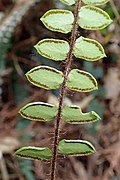
Nephrolepis exaltata, known as the sword fern or Boston fern, is a species of fern in the family Lomariopsidaceae. It is native to the Americas. This evergreen plant can reach as high as 40–90 centimetres (16–35 in), and in extreme cases up to 1.5 metres. It is also known as the Boston swordfern, wild Boston fern, Boston Blue Bell Fern, tuber ladder fern, or fishbone fern.

Dryopteris filix-mas, the male fern, is a common fern of the temperate Northern Hemisphere, native to much of Europe, Asia, and North America. It favours damp shaded areas in the understory of woodlands, but also shady places on hedge-banks, rocks, and screes. Near the northern limit of its distribution it prefers sunny, well-drained sites. It is much less abundant in North America than in Europe. The plant is sometimes referred to in ancient literature as worm fern, reflecting its former use against tapeworm.

Gymnocarpium dryopteris, the western oakfern, common oak fern, oak fern, or northern oak fern, is a deciduous fern of the family Cystopteridaceae. It is widespread across much of North America and Eurasia. It has been found in Canada, the United States, Greenland, China, Japan, Korea, Russia, and most of Europe.

Osmunda regalis, or royal fern, is a species of deciduous fern, native to Europe, Africa and Asia, growing in woodland bogs and on the banks of streams. The species is sometimes known as flowering fern due to the appearance of its fertile fronds.
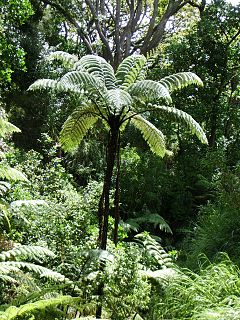
Sphaeropteris medullaris, synonym Cyathea medullaris, commonly known as mamaku or black tree fern, is a large tree fern up to 20 m tall. It is distributed across the south-west Pacific from Fiji to Pitcairn Island. Its other Māori names include katātā, kōrau, or pītau.

Pellaea is a genus of ferns in the Cheilanthoideae subfamily of the Pteridaceae. The genus name is derived from the Greek word πελλος (pellos), meaning "dark," and refers to the brown stems. Many members of the genus are commonly known as cliffbrakes. They primarily grow in rocky habitats, including moist rocky canyons, slopes, and bluffs.

Polystichum aculeatum, the hard shield-fern, is an evergreen fern native to Europe. It is most abundant in upland regions of the British Isles and western France, where it benefits from the combination of mild winters and moist summers, but also occurs more locally across most of Europe except northern Scandinavia, northern Russia; in the Mediterranean region it is confined to high altitudes. It grows on steep slopes in woodlands. it is sometimes considered an indicator of the presence of ancient woodlands.
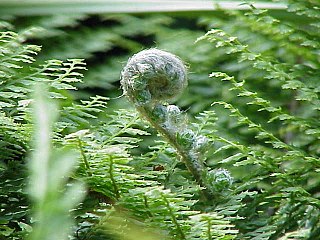
Polystichum setiferum, the soft shield fern, is an evergreen or semi-evergreen fern native to southern and western Europe. The stalks and most midribs are coated with attractive cinnamon-brown scales. The Latin specific epithet setiferum means “with bristles”.

Dryopteris erythrosora, the autumn fern or Japanese shield fern, is a species of fern in the family Dryopteridaceae, native to east Asia from China and Japan south to the Philippines, growing in light woodland shade on low mountains or hills.

Prostanthera rotundifolia, commonly known as round-leaved mintbush or round-leaf mint-bush is a species of flowering plant in the mint family Lamiaceae, and is endemic to south-eastern Australia. It is an erect shrub with aromatic branches covered with short hairs and glands, egg-shaped to more or less round leaves and purple to mauve or pinkish flowers on the ends of branchlets.
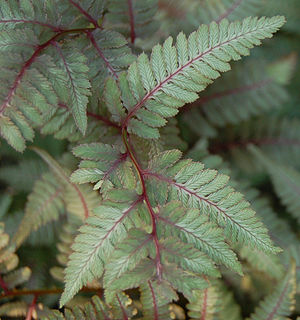
Athyrium niponicum, the Japanese painted fern, is a species of fern native to eastern Asia.
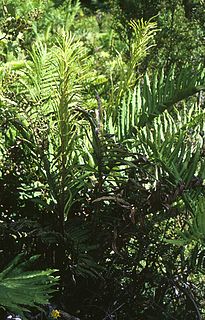
Parablechnum cordatum, the Chilean hard fern or costilla de vaca, is a fern of the family Blechnaceae, native to Chile. It is also found in neighboring areas of Argentina and the Juan Fernández Islands.
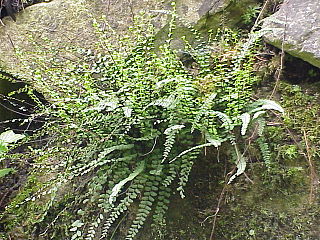
Asplenium trichomanes, the maidenhair spleenwort, is a small fern in the spleenwort genus Asplenium. It is a widespread and common species, occurring almost worldwide in a variety of rocky habitats. It is a variable fern with several subspecies.
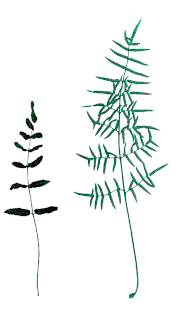
Pellaea atropurpurea, commonly known as purple-stem cliffbrake or just purple cliffbrake, is a fern native to North and Central America. Brake is an old word for fern, related to the word bracken. Like many other members of the Pteridaceae, it is a rock plant, needing a calcareous substrate.

Pteris cretica, the Cretan brake, ribbon fern, or Cretan brake fern, is a species of evergreen fern in the family Pteridaceae, native to Europe, Asia and Africa.

Woodwardia radicans, the chain fern, European chain fern or rooting chainfern, is a species of fern in the family Blechnaceae, mainly found in Macaronesia and southwestern Europe, but is also found in southern Italy and Crete. Growing to 1.8 m (6 ft) tall by 2 m (7 ft) broad, it is evergreen with arching fronds. The pinnae have curved, finely-toothed segments. The plant derives its common name from the linked sori on the undersides of the fronds.

Myriopteris alabamensis, the Alabama lip fern, is a moderately-sized fern of the United States and Mexico, a member of the family Pteridaceae. Unlike many members of its genus, its leaves have a few hairs on upper and lower surfaces, or lack them entirely. One of the cheilanthoid ferns, it was usually classified in the genus Cheilanthes as Cheilanthes alabamensis until 2013, when the genus Myriopteris was again recognized as separate from Cheilanthes. It typically grows in shade on limestone outcrops.
Myriopteris allosuroides is a moderately-sized fern of Mexico, a member of the family Pteridaceae. Unlike many members of its genus, its rachides are grooved on the upper surface and largely free of hairs or scales. One of the cheilanthoid ferns, it was usually classified in the genera Cheilanthes or Pellaea until 2013, when the genus Myriopteris was again recognized as separate from Cheilanthes. It typically grows on dry, rocky slopes over acidic, particularly basaltic, rock.
Argyrochosma connectens is a small cheilanthoid fern endemic to Sichuan, China. It is the only member of its genus known from Asia. Relatively rare, it is found growing in the crevices of limestone rocks in hot, dry valleys. The species was long classified in the genus Pellaea, but after a phylogenetic study in 2015 was transferred to Argyrochosma.
Argyrochosma formosa is a fern known from eastern and central Mexico and Guatemala. It grows on rocky slopes, particularly on limestone. Unlike many members of the genus, it lacks white powder on the underside of its leaves. First described as a species in 1842, it was transferred to the new genus Argyrochosma in 1987, recognizing their distinctness from the "cloak ferns".

